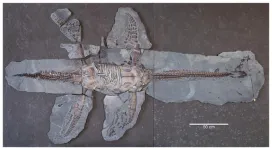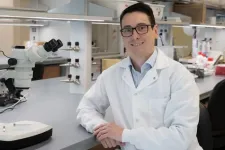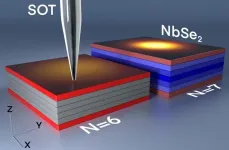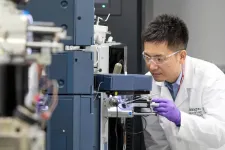(Press-News.org) A nearly complete specimen of Plesiopterys wildi from Germany provides fresh insights into plesiosaur diversity and regional specialisation
A newly described plesiosaur fossil from southern Germany is providing crucial evidence about the diversification of these ancient marine reptiles during the Early Jurassic. Published in PeerJ Life and Environment, the study details the discovery and analysis of an exceptionally well-preserved Plesiopterys wildi specimen, which offers new clues about the evolution and geographic distribution of plesiosaurs in Europe nearly 180 million years ago.
Unearthed from the Lower Jurassic Posidonienschiefer Formation near Holzmaden, the fossil—referred to as MH 7—is one of the most complete articulated plesiosaur skeletons found in the region. Unlike ichthyosaurs and marine crocodile relatives, which dominate the fossil record of this formation, plesiosaurs are comparatively rare. The new discovery, therefore, provides a rare glimpse into the biodiversity of these long-necked marine reptiles.
Key Findings:
A pivotal new specimen of Plesiopterys wildi – MH 7 represents a subadult individual, refining the known characteristics of this species and confirming its validity as a distinct taxon.
Stepwise evolution towards cryptoclidids – Phylogenetic analysis positions Plesiopterys wildi as an early-diverging plesiosauroid, closely related to Franconiasaurus brevispinus, suggesting a gradual evolutionary transition towards more derived cryptoclidids of the Late Jurassic.
Possible regional endemism – The discovery supports the idea that plesiosaur species may have been regionally distinct within the epicontinental seas of Early Jurassic Europe, reinforcing patterns of paleobiogeographical segregation.
“The Holzmaden specimen gives us an unprecedented look at Plesiopterys wildi in a more mature stage of development, allowing us to refine our understanding of this species and its place in plesiosaur evolution,” said lead author Miguel Marx from Lund University. “It also suggests that distinct plesiosaur communities may have evolved in different regions of the European seas during the Early Jurassic.”
Implications for Plesiosaur Evolution and Biogeography
The findings highlight the Early Jurassic as a crucial period for plesiosaur evolution, as early forms diversified and set the stage for later groups that would dominate marine ecosystems. The presence of unique plesiosaur species in different parts of Europe reinforces the hypothesis that early members of this group may have been geographically restricted.
“Our research reinforces that plesiosaurs were already evolving specialized adaptations and distinct regional lineages much earlier than we used to believe,” added co-author Sven Sachs. “This has important implications for understanding how marine reptiles responded to environmental changes in the Jurassic seas.”
Study Details and Contact Information
The study was conducted by an international team of researchers from Lund University, Naturkunde-Museum Bielefeld, Uppsala University, and Urwelt-Museum Hauff.
END
New plesiosaur discovery sheds light on early Jurassic evolution and plausible endemism
A nearly complete specimen of Plesiopterys wildi from Germany provides fresh insights into plesiosaur diversity and regional specialization
2025-03-31
ELSE PRESS RELEASES FROM THIS DATE:
Chance discovery improves stability of bioelectronic material used in medical implants, computing and biosensors
2025-03-31
HOUSTON – (March 31, 2025) – A chance discovery led a team of scientists from Rice University, University of Cambridge and Stanford University to streamline the production of a material widely used in medical research and computing applications.
For over two decades, scientists working with a composite material known as PEDOT:PSS, used a chemical crosslinker to make the conductive polymer stable in water. While experimenting with ways to precisely pattern the material for applications in biomedical optics, Siddharth Doshi, a doctoral student at Stanford collaborating with Rice materials scientist Scott Keene, ...
Using artificial intelligence to calculate the heart’s biological age through ECG data predicts increased risk of mortality and cardiovascular events
2025-03-31
Vienna, Austria- 31 March 2025 - While everybody’s heart has an absolute chonological age (as old as that person is), hearts also have a theoretical ‘biological’ age1 that is based on how the heart functions. So someone who is 50 but has poor heart health could have a biological heart age of 60, while someone of 50 with optimal heart health could have a biological heart age of 40.
Researchers presenting a new study today at EHRA 2025, a scientific congress of the European Society of Cardiology (ESC), demonstrated that by using artificial intelligence (AI) to analyse standard ...
“She loves me, she loves me not”: physical forces encouraged evolution of multicellular life, scientists propose
2025-03-31
WOODS HOLE, Mass. -- Humans like to think that being multicellular (and bigger) is a definite advantage, even though 80 percent of life on Earth consists of single-celled organisms – some thriving in conditions lethal to any beast.
In fact, why and how multicellular life evolved has long puzzled biologists. The first known instance of multicellularity was about 2.5 billion years ago, when marine cells (cyanobacteria) hooked up to form filamentous colonies. How this transition occurred and the benefits it accrued to the cells, though, is less than clear.
This week, a study originating from the Marine Biological Laboratory (MBL) presents a striking example of cooperative ...
The hidden superconducting state in NbSe₂: shedding layers, gaining insights
2025-03-31
Researchers have discovered an unexpected superconducting transition in extremely thin films of niobium diselenide (NbSe₂). Published in Nature Communications, they found that when these films become thinner than six atomic layers, superconductivity no longer spreads evenly throughout the material, but instead becomes confined to its surface. This discovery challenges previous assumptions and could have important implications for understanding superconductivity and developing advanced quantum technologies.
Researchers at the Hebrew University of Jerusalem have made a surprising discovery about how superconductivity ...
New AI models possible game-changers within protein science and healthcare
2025-03-31
Researchers have developed new AI models that can vastly improve accuracy and discovery within protein science. Potentially, the models will assist the medical sciences in overcoming present challenges within, e.g. personalised medicine, drug discovery, and diagnostics.
In the wake of broadly available AI tools, most technical and natural sciences fields are advancing rapidly. This is particularly true in biotechnology, where AI models power breakthroughs in drug discovery, precision medicine, gene editing, food security, and many other research areas.
One sub-field is proteomics – the study of proteins on a large scale – where ...
Highly accurate blood test diagnoses Alzheimer’s disease, measures extent of dementia
2025-03-31
A newly developed blood test for Alzheimer’s disease not only aids in the diagnosis of the neurodegenerative condition but also indicates how far it has progressed, according to a study by researchers at Washington University School of Medicine in St. Louis and Lund University in Sweden.
Several blood tests for Alzheimer’s disease are already clinically available, including two based on technology licensed from WashU. Such tests help doctors diagnose the disease in people with cognitive symptoms, but do not indicate the ...
Mind the seismic gap: Understanding earthquake types in Guerrero, Mexico
2025-03-31
Plate temperature and water release can explain the occurrence of different types of earthquakes in Guerrera, Mexico. The Kobe University simulation study also showed that the shape of the Cocos Plate is responsible for a gap where earthquakes haven’t occurred for more than a century. The results are important for accurate earthquake prediction models in the region.
Where one tectonic plate is pushed down by another, the resulting stress is released in various tectonic events. There are catastrophic megathrust earthquakes, unnoticeable “slow slip events,” and continuous low-frequency “tectonic tremors,” and knowing ...
One hour’s screen use after going to bed increases your risk of insomnia by 59%, scientists find
2025-03-31
Scientists have found another reason to put the phone down: a survey of 45,202 young adults in Norway has discovered that using a screen in bed drives up your risk of insomnia up by 59% and cuts your sleep time by 24 minutes. However, social media was not found to be more disruptive than other screen activities.
“The type of screen activity does not appear to matter as much as the overall time spent using screens in bed,” said Dr Gunnhild Johnsen Hjetland of the Norwegian Institute of Public Health, ...
Canada needs to support health research at home and abroad
2025-03-31
In the face of major changes to federal policy and funding in the United States, Canada should support Canadian researchers with adequate funding to ensure long-term research in health and science, argue authors in two articles published in CMAJ (Canadian Medical Association Journal).
“As the US stands on the brink of tearing down its exemplary system for covering the full costs of research, Canada, with its flawed federal system for indirect costs, should heed the recent commissioned science policy report and a chorus of advocacy calling for an enhanced indirect cost system,” writes Dr. William Ghali, vice-president ...
Cannabis use disorder among insured pregnant women in the US between 2015-2020
2025-03-31
Cannabis use has been increasing during pregnancy, according to researchers at Columbia University Mailman School of Public Health and the Columbia University Irving Medical Center. Previous research has observed that past-month cannabis use has more than tripled among pregnant women in the U.S. from 2002-2020 with self-reported cannabis use rising from 1.5 percent to 5.4 percent over the 18 years of tracking data. The findings are published in the American Journal of Preventive Medicine.
Medical guidelines recommend that pregnant women abstain from cannabis because of its link to an increased risk of adverse maternal ...
LAST 30 PRESS RELEASES:
Researchers develop AI Tool to identify undiagnosed Alzheimer's cases while reducing disparities
Seaweed based carbon catalyst offers metal free solution for removing antibiotics from water
Simple organic additive supercharges UV treatment of “forever chemical” PFOA
£13m NHS bill for ‘mismanagement’ of menstrual bleeds
The Lancet Psychiatry: Slow tapering plus therapy most effective strategy for stopping antidepressants, finds major meta-analysis
Body image issues in adolescence linked to depression in adulthood
Child sexual exploitation and abuse online surges amid rapid tech change; new tool for preventing abuse unveiled for path forward
Dragon-slaying saints performed green-fingered medieval miracles, new study reveals
New research identifies shared genetic factors between addiction and educational attainment
Epilepsy can lead to earlier deaths in people with intellectual disabilities, study shows
Global study suggests the underlying problems of ECT patients are often ignored
Mapping ‘dark’ regions of the genome illuminates how cells respond to their environment
ECOG-ACRIN and Caris Life Sciences unveil first findings from a multi-year collaboration to advance AI-powered multimodal tools for breast cancer recurrence risk stratification
Satellite data helps UNM researchers map massive rupture of 2025 Myanmar earthquake
Twisting Spins: Florida State University researchers explore chemical boundaries to create new magnetic material
Mayo Clinic researchers find new hope for toughest myeloma through off-the-shelf immunotherapy
Cell-free DNA Could Detect Adverse Events from Immunotherapy
American College of Cardiology announces Fuster Prevention Forum
AAN issues new guideline for the management of functional seizures
Could GLP-1 drugs affect risk of epilepsy for people with diabetes?
New circoviruses discovered in pilot whales and orcas from the North Atlantic
Study finds increase in risk of binge drinking among 12th graders who use 2 or more cannabis products
New paper-based technology could transform cancer drug testing
Opioids: clarifying the concept of safe supply to save lives
New species of tiny pumpkin toadlet discovered in Brazil highlights need for conservation in the mountain forests of Serra do Quiriri
Reciprocity matters--people were more supportive of climate policies in their country if they believed other countries were making significant efforts themselves
Stanford Medicine study shows why mRNA-based COVID-19 vaccines can cause myocarditis
Biobanking opens new windows into human evolution
Sky-high smoke
AI tips off scientists to new drug target to fight, treat mpox
[Press-News.org] New plesiosaur discovery sheds light on early Jurassic evolution and plausible endemismA nearly complete specimen of Plesiopterys wildi from Germany provides fresh insights into plesiosaur diversity and regional specialization





